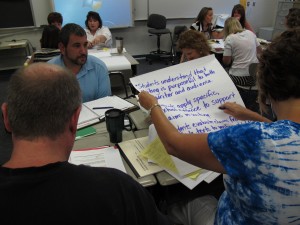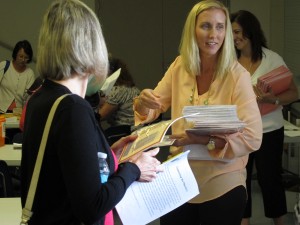Five Things We Learned About Common Core This Summer

John O'Connor / StateImpact Florida
Venice High School English teachers, from left, Larry Burke, Kathleen Jones and LaRay Biziawski write a learning goal at a recent Common Core training. Venice High School assistant principal Joshua Leinweber, in the blue shirt, joined them.
We spent a lot of time this summer watching and listening as Florida school districts trained teachers about what to expect when the state makes the full switch to new education standards next year.
Florida is one of 45 states to fully adopt the Common Core State Standards, which outline what students are expected to know in math and English at the end of each grade. The standards also put more emphasis on reading and writing in other subjects.
Here’s five things we learned:
1. Common Core Will Turn The Keys Over To The Students
This is probably the most important change we noticed.
Common Core emphasizes that students know the underlying concepts, and not just the formula for how to reach an answer.
Hillsborough County teaching coach Cynthia Crim put it this way for several hundred teachers at a Frost Elementary School math training: Don’t tell students area equals length times width, and then have them calculate it ten times. Ask questions that lead them to discover the formula on their own or working with classmates.
“We’re going to have students explore different patterns; And we’re going to be asking questions that really require students to think and discover patterns within numbers,” Crim said. “You are going to have to be really strategic in what problem you’re showing to your students for them to see patterns.”
The intent of Common Core is that when students graduate high school they are prepared for college-level courses or could land a job that pays enough to support a family. One way teachers are being trained to develop those skills is allowing students to work in groups of different sizes.
They’ll teach each other how to solve a problem in math class, compare notes, and figure out more efficient solutions. In English and other classes, they’ll debate which ideas are supported by their fiction and non-fiction texts – and which are not.
Teachers said it will be a big change, and one that will require more preparation on their part. They said they’ll have to think on their feet more, too, identifying and choosing students who discovered answers in different ways for class discussions.
“Anything you were comfortable doing as a kid and the procedures that you learned, it’s the complete opposite of that,” Crim said of Common Core’s effect on math. “It’s a 180 from how we were taught.”
2. But Teachers Have More Freedom Too
It seems counter-intuitive, but teachers said they’ll have more control over class lessons when they let students take charge.
At a Sarasota County training session, teachers said they think Common Core will mean more autonomy over their own classrooms.
Common Core also includes fewer topics than Florida’s current standards, and teachers said they will have more flexibility over the course of the year. They won’t have to rush through topics just to make sure they tick off all of them on a long list of items.
“The coolest thing is that they are taking more off our plate so that we can dive deeper into it,” said Hillsborough County elementary math teacher Tricia Craig. “Right now we’re teaching all this stuff and there’s not always time to do the ‘why?’ But this is going to give us the time to do those ‘whys?’ and let our kids be true thinkers of why this process is going on.”

John O'Connor / StateImpact Florida
Cynthia Crim hands out Common Core materials to teachers following a math training session.
3. Some Common Core Training Had Little To Do With Common Core
Rolled up into the Hillsborough County session were that tips that seemed to be less about Common Core and more about tips and tricks to create more engaging lessons. School districts had to do large-scale teacher training to prepare for Common Core, so why not also show teachers how to use technology they have at hand to modernize lessons?
Common Core emphasizes helping students understand why they are learning lessons and when they will use it later in school or work. But Crim’s tips seemed smart whether used in a Common Core classroom or not.
For instance, Crim told teachers to customize exercises for the students in the class.
She talked about a word problem that asked how many vases would be required for 30 roses if each vase holds 6 roses? But how many students say they want to be florists? Crim asked the room.
Instead, she put up on the screen a mobile phone photo of a cafeteria table with six seats. Change the question so it’s asking how many six-seat tables would be needed to seat 30 students, Crim said.
Adding familiar elements to lessons is a sneaky way to get kids thinking about math outside of class, Crim said.
“You might be at a school where they think it’s not cool to talk about math,” Crim told the teachers, “but I guarantee you they’ll be thinking about it when they go in the cafeteria.”
Another idea: When students write those “what I did this summer” essays to start the school year, keep them and work those facts into math word problems. So if a student plays football, work his team name, teammates, position and other details into the word problems.
4. Some Districts Did A Better Job Of Using Common Core Techniques Than Others
At the Hillsborough County training session, Crim and other leaders were constantly handing out tasks for teachers to work on in small groups. Then they would call everyone back together to discuss and debate.
Crim would use different exercises to demonstrate the eight types of thinking skills that Common Core seeks to develop for math students. These are known as Standards for Mathematical Practice, and include “Reason abstractly and quantitatively” and “look for and make use of structure.”
In Sarasota County, the focus for English teachers during one session was precise use of language, editing and rewriting – all skills emphasized by Common Core.
But the half-day session we attended in Manatee County was a much more traditional lesson.
The leaders stood at the front of the classroom. They handed out packets of information and asked teachers to read along. There was less emphasis on collaborative group work.
This training might be as effective as any other, but the difference in approach jumped out at us.
To hear some examples of Common Core concepts at work during training, listen to our broadcast story.
5. Teachers Seem Enthusiastic
To be sure, there is plenty of criticism of Common Core.
Depending on which exam states choose, it could mean more time each year testing. Others worry shared standards reduce or limit local control over education. Others have said Common Core could fade away like other ineffective education trends that have come and gone.
But we talked to dozens of teachers and most of them were excited for the change. Most agreed the standards would be more challenging for their students, and most said Common Core would mean significant changes in how they do their job.
“This is going to help me to be a better teacher,” Craig said.
Hillsborough County teacher Alexis Hill agreed.
“It’s asking the kids to do so much more than what they were doing before,” she said. “And it asks teachers to do more as well…we’re kind of stepping back and letting them take control.”

